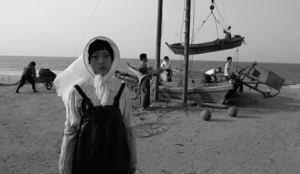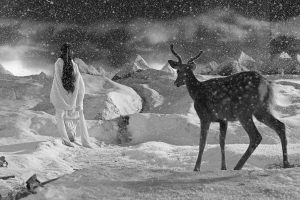Australian public galleries had to work hard to attract audiences last year, but in 2015 the degree of difficulty will crank up a few more notches. In such a climate institutions feel pressured to take a more populist approach – preferring shows that will appeal to a non-specialist audience over displays perceived as difficult or obscure.
The National Gallery of Victoria has led the way, with the extraordinary sideshow of Jean Paul Gaultier drawing the crowds. As if this wasn’t enough, when visitors enter the building on St. Kilda Road the first thing they see is a functioning merry-go-round by Carsten Höller.

On the other hand, the NGV has hosted no fewer than four retrospectives for Australian artists over the past year: Inga King, Sue Ford, David McDiarmid and Robert Jacks. By contrast, the most recent full-scale retrospective of an Australian artist held at the Art Gallery of NSW was Barry Pearce’s Justin O’Brien survey at the end of 2010.
So while the NGV may be flirting dangerously with over-the-top populism, it can argue that such shows are balanced by a proven commitment to local art. Here I’ll leave the AGNSW, which fares badly in any comparison, and turn to the Australian Centre for the Moving Image – a museum that has made strenuous efforts to achieve a balance between popular and specialist exhibitions. Over the past few years ACMI has resisted the temptation of devoting itself solely to crowd-pleasers such as Dreamworks Animation (Apr.–Oct. 2014), giving space to local moving image artists such as Angelica Mesiti, Shaun Tan, Warwick Thornton and David Rosetzky; and to international stars such as William Kentridge and Candice Breitz.
Yang Fudong: Filmscapes, is no blockbuster, but it is important that Australians get to see the work of an artist who has become one of the most highly regarded figures in contemporary audio-visual art. This is not the first time Yang (b.1971) has shown in Australia. He was included in the 2006 Asia Pacific Triennial, and in 2010 was featured in the Sydney Biennale and the Sherman Contemporary Art Foundation. Filmscapes is his first genuine survey in this part of the world.
Curator Ulanda Blair has brought together four diverse pieces: East of Que Village (2007); The Fifth Night (2010); Yeijiang/The Nightman Cometh (2011); and a new work jointly commissioned by ACMI and the Auckland Art Gallery Toi o Tamaki, The Coloured Sky: New Women II (2014). If that sounds like a slender haul, remember that most of these pieces involve lengthy multiple-screen projections. In addition ACMI has already held a special screening of Yang’s 4 hour, 50 minute magnum opus, Seven Intellectuals in a Bamboo Forest (Parts I-IV) (2003-07), as part of a season of events called China Up Close. It’s pleasing that the wall labels and catalogue texts are printed in both English and Chinese.

As far as I know the only part of Filmscapes to have been seen before in Australia is East of Que Village, which is probably the least typical of Yang’s works. Visitors to the Sydney Biennale were disturbed by this bleak, six-channel projection set in a desolate region of northern China. Shot in grainy black-and-white, the film shows a wasteland in which a pack of mangy dogs gnaw away at the bones of their dead companions. Cut to the village where a group of peasants lead lives not far removed from those of the dogs. It’s literally and metaphorically a dog-eat-dog existence, which shows the other side of China’s economic miracle.

Yang has said Que Village is based on his childhood memories of northern China, and is meant to prompt reflection on whether humans have a spiritual life. It’s a big question, given the brutality of everyday survival in such a place – and a fruitless task to scan the film for signs of grace or redemption.
The artist might argue that the emptiness of life in Que Village is echoed by the feelings of aimlessness, boredom, and futility that afflict so many characters in his films, whether they are young, urban intellectuals or warriors from a bygone dynasty. Yeijiang/The Nightman Cometh, deposits both types in a snowy wilderness. The show’s only single-channel projection, it is also the most bewildering piece, as characters from two different ages inhabit the same space with no apparent connection.

What does a soldier in ancient battle armor have in common with a white-suited dandy from jazz-age Shanghai? How does a woman in traditional robes relate to one in a cheongsam? It feels as though we are slipping back and forth in time, with figures occupying the same physical space being completely unaware of their counterparts. Both sets of characters seem to be drifting, as if they have been removed from their normal roles and left to fend for themselves in a landscape that is eerily beautiful but almost devoid of features.
The experience of upheaval and dislocation has been a common factor throughout Chinese history and it runs like an undercurrent through all of Yang’s work. Because he avoids conventional narrative in favour of a cryptic, fragmented style of story-telling we are prompted to fill in the gaps from our own imaginations.
In The Fifth Night we find ourselves staring at scenes that have been framed as carefully as a classic black-and-white photograph. A fractured film noir shot on a set made to duplicate the Shanghai of the 1930s, we follow a handful of different, over-lapping story lines. Seven characters have been captured by seven different cameras, shooting simultaneously from different positions. Watching the ten-minute sequence on seven screens set in row is a slightly vertiginous experience, as one notices details such as a cyclist from one channel appearing in the distance on another. I watched this sequence several times but the story never became less of a puzzle.

One suspects that Yang does not work with fully-formed stories. He evokes mood and atmosphere, inserting sly references to both Chinese and western films. Pieces such as The Fifth Night have the quality of dreams, in which we feel there is a concealed meaning to a series of disjointed, apparently random events.
Yang has described his work as “abstract filmmaking.” He is not making cinema, but artworks that draw on many cinematic devices. He seems almost indifferent to the difficulties of viewing an epic work such as Seven Intellectuals in a Bamboo Forest on small screens in a museum installation. Yang is happy for viewers to sample his creations one piece at a time, as if understanding might arrive like Buddhist Enlightenment, rather than through careful observation and analysis. This makes demands on an audience that will alienate a good number of viewers. Others, and here I raise my hand, will find themselves drawn into his net.
The most recent work, The Coloured Sky: New Women II, is a departure for Yang, albeit with many familiar elements. As his first foray into digital colour there is nothing timid or half-hearted in the way he has saturated a five-channel video with bright, lurid hues. It shows three young women wearing old-fashioned bathing suits, looking like they are enjoying a holiday at the beach. Yet this beach is punctuated by a series of coloured glass panels that reflect or distort the girls’ appearances. There are also a few stuffed deer, and a live snake that may be a coy reference to the serpent in the Garden of Eden.
Imagine a surf romp drenched in the acid colours of late R.W.Fassbinder films, in which three nubile girls project their “secret dreams and anxieties”, as the catalogue puts it. Yang has tried to make his subjects seem innocent and naive, yet quietly alert to their own sexuality. “These girls have secrets that they never tell anyone,” he says, but this might be said about any of the characters in Yang’s videos. Like those other mysterious figures – the warrior in armour, the Shanghai dandy, the tribe of glamorous young people who walk around dealing with their latest existential crisis – one must read Yang’s bathing beauties as symbols or symptoms of China’s re-awakening. As a once great empire that is reclaiming its former glories by different means, China too is a strange mixture of innocence, shrewdness and insecurity, with the sexiest economy in the world.
Yang Fudong: Filmscapes
Australian Centre for the Moving Image, Melbourne
Until 15 March 2015
Auckland Art Gallery Toi o Tamaki,
Auckland, New Zealand
19 Sept. – 31 Jan. 2016
Published in the Sydney Morning Herald, Saturday 17th January, 2015




